
 |
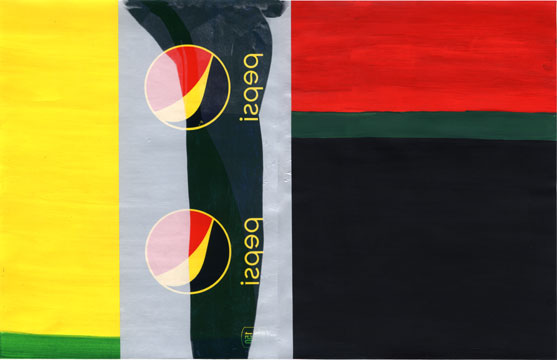
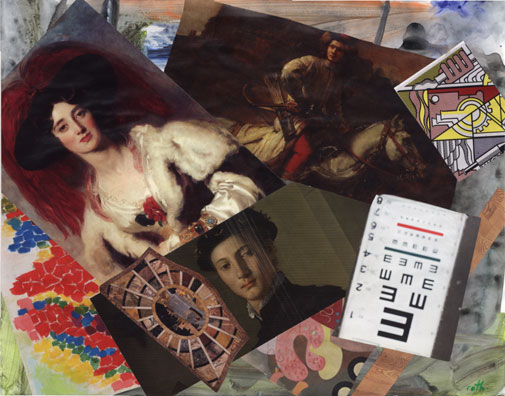
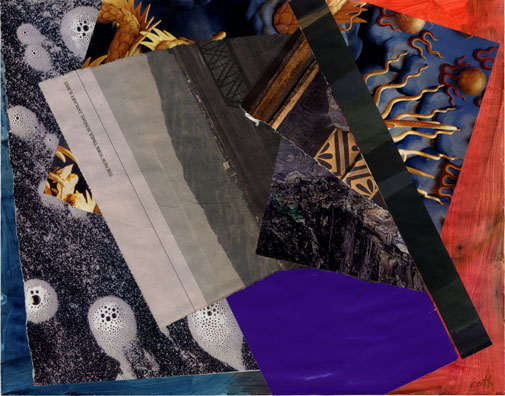
Tinsquo's curatorial project, Adjacent To Life, presents The Past Sealed Away by Deborah Carruthers. Marisa Malone conducted the following interview with the artist:
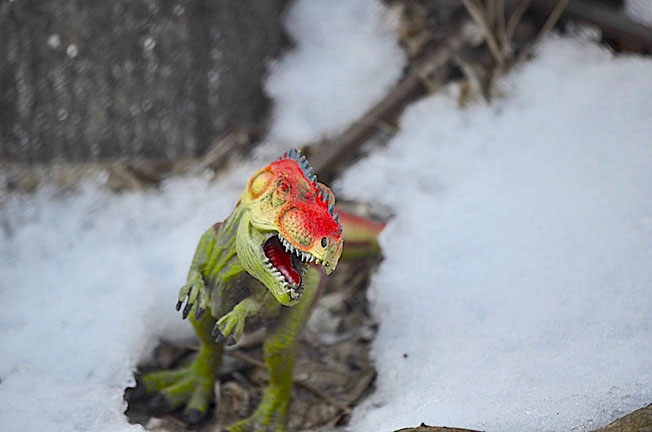
Deborah Carruthers’ work is built from layers of research, history, and mediums compounded into dense yet clear evocations of our evolving climate.
Showing at Adjacent to Life are two bodies of work, Allegory for a New Ice Age and Re-Viewed: the Athabasca Glacier.
With a childlike curiosity and a researcher's attention to detail, Carruthers creates work that embodies the depth of her topics. Every detail is intentional and rooted in the subject matter. Using research as her foundation, her creative interpretations can expand way out, taking shape in multiple forms and mediums, including sound, paint, photography, text, performance, and even mud.
Talking with Carruthers you get the sense that her eyes are wide open to the world and her ideas have free reign. Following her intuition and interests, she magnifies hidden worlds that most of us might overlook, and in doing so shows us their beauty and importance.
The following conversation took place over email.
When did you become interested in the climate and climate change issues? Was there a specific moment or event you can recall that sparked something for you?
Growing up, I spent a lot of time in the Laurentians, north of Montréal, Québec. My father had grown up on a farm close to where we had our family cottage on Upper Rainbow Lake. To me, it was paradise: a log house with no electricity or running water that was at the head of a pristine lake that only had 2 log houses on it (excluding the beaver lodges). A spring with the sweetest water I’ve ever tasted was less than a minute from the cottage. Growing up all I wanted to do was spend time there; it was a place that I knew better than my own skin, and our neighbours were the wildlife. I grew up alongside them and recognized many of the creatures that came back year after year.
I would often canoe down the lake to the bay where the loons nested, and swim with them. In the early 1970’s, when I was about 12 or 13, I’d noticed that there were often cracked eggs on their nests, and that their breeding success was greatly diminished. I kept a lake diary for about 30 years: I’d sketch the moose, birds, fish, frogs, toads, and insects; their nests and eggs, draw maps, record weather, record behaviour, disease, and anything else that caught my attention. I was able to see the difference that acid rain made, and more importantly, the effect of people upon places.
I saw the way that people clearing plants and trees to the shoreline changed not just the immediate ecology, but the ecology going way back into the forest. That putting in cutlines for electrical towers and roads for logging changed behavior, not just of the creatures that would normally live there, but of the people that shared their space.
I’m just 63 years-young now, and still spending as much time as possible in the Laurentians, alas no longer at that lake. The time that I spend up there has always coloured how I view other places and spaces.
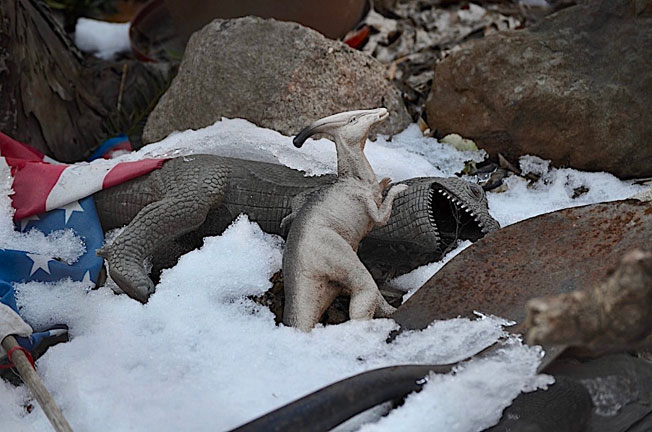
Did you study art in university or have you found your way to it through other channels?
In university, I initially graduated with a double-major: a specialization in Psychology (psychopharmacology- aka brain chemistry) and a major in community development. Some years later, I decided to go back and study Biology, both molecular and ecology, didn’t finish the degree.
I really became aware of the arts as a vocation when I was 7. My family was visiting the American pavilion at Expo 67, a geodesic dome designed by Buckminster Fuller. As you rode the escalators through this enormous open space, there were these massive abstract paintings by artists such as Robert Motherwell, Kenneth Noland, and most importantly for me, Helen Frankenthaler. She had this wonderful 30’ x 16’ painting, Guiding Red (although described on the works list for the exhibition as Painting for Expo, 1967). I’d never seen works like this before, and not at this scale, and hers absolutely transfixed me. It was the first time that I was struck by the idea that this was something that one could DO – as a vocation!
I’d always participated in the arts: spoken word, painting, drawing, photography, and decided when I hit my 40th birthday that I was going to fully go for it. When I hit my 50’s, I decided to go for my masters degree in studio arts. I can’t ever imagine not creating now.
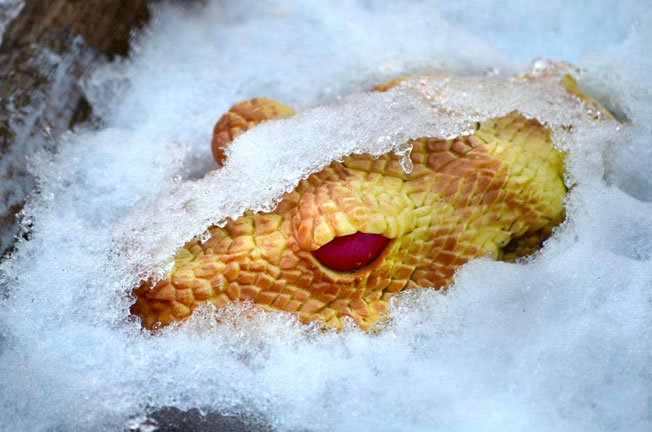
I love the Allegory for a New Ice Age work! What a coincidence that you should come across these toy dinosaurs emerging from the snow as you’re on your way to a climate change meeting. Can you tell me more about what this work evokes for you?
Thank you! It evokes so so many things for me… (lol – one of the things you may start to notice about me is I obsessively overthink my work – all tangents welcomed!).
So… initially the images themselves were striking: plastic dinosaurs emerging from the snow- could there be a better trope related to climate change?! As images, what makes these works believable on another level is that they truly are emerging from the snow as it melts rather than being staged. They are our contemporary woolly mammoths, though not nearly as friable! You can look at the literal implications, thinking about the evident effects that discarded plastic has on the environment coupled with the extinction events of dinosaurs.
However, it also makes me consider ideas of intergenerational memory as relates to environmental issues, in the manner of the philosopher Matthias Fritsch (especially as he relates in his book Taking turns with the Earth: phenomenology, deconstruction, and intergenerational justice). When we do nothing to take action now, we are showing clear indifference to our future generations.
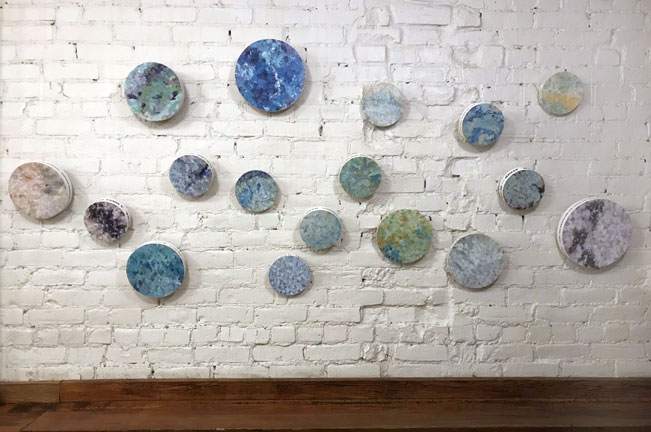
Can you go into more depth about what drew you to create the works in Re-Viewed: the Athabasca Glacier?
I’d done a research trip to the glacier in 2017 preparatory to my residency at the Peter Wall Institute for Advanced Studies, a think tank at the University of British Columbia where I intended to do further work on glaciers and ice. I started looking through my files for images, looking for some of the original journal articles. Then, I found a file containing printouts of travel reviews of the Athabasca Glacier on TripAdvisor and Yelp.
The absurdity of these reviews gobsmacked me:
FUN, BUT NOT WORTH THE MONEY.
IT’S NOT THAT BIG OF A DEAL.
A SIGHT THAT WAS A LITTLE UNDERWHELMING.
THE WOW FACTOR JUST WASN'T THERE FOR US.
After wondering whether these people had indeed been to the same place as me, I reflected upon what they would have seen.
The differences of scale of the environments and vistas one can see on the glacier vary from majestic to microscopic (the philosopher Gaston Bachelard got it right in his discussions of “immense immensities”).
As the people who wrote the reviews had the opportunity to view the glacier as closely as they wished within a given area, I chose to represent the intimate views of the ice that I was privileged to see when I was there: lying prone with my face to the ice. This was a view that they too could have chosen.
I often think about how intergenerational memories are formed: how they’re held, expressed, become part of us and of those who come after. Could their impressions of this glacier influence the impressions of later generations? Could its importance to our environment and the devastation of its loss be diminished by the casual reviews of visitors?
I chose to create these intimate, though not mimetic views of the ice on the birch panels, whose diameters evoke the ice cores. The titles of the individual works are quotes from travel reviews of the glacier and are stenciled as 3 repeats around the edges of the paintings. The reason I used stencils for the text is that stencils are often used to label the crates used to transport the ice core samples.
Looking at the works face on, I could recall that feeling of immersion in the ice, of looking for the past sealed away. Seen obliquely, the text of the review is seen, and provides a different perspective of the view, albeit not as poetic.
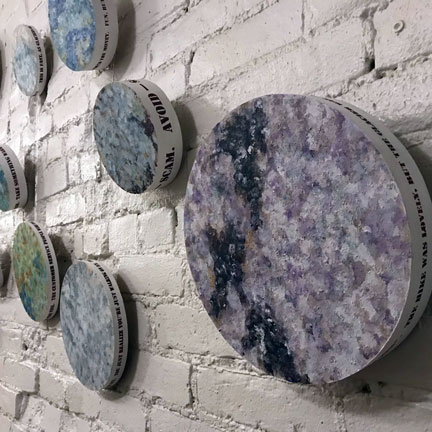
What sparked your interest in ice specifically?
My interest in ice started about 10 years ago during a visit with some bee-researchers – (see what I mean about tangents?). En route to one of the research pavilions, we passed these strange, empty metal racks on wheels with V-shaped shelves. When I asked what they were for, the researchers told me they were for ice cores, and started telling me about how labs were amalgamating their ice core collections because of budget cuts. The more questions I asked, the more alarmed I felt. This triage resulted in many core samples being discarded, and their invaluable information irretrievably lost.
And so I started to think about ice and what its loss could mean. These ice cores provide invaluable information regarding not only the anatomy of the glacier, but climatic, geologic, ecologic, and anthropologic conditions both local and global.
When I first started my research, I came across this quote in a book of short stories:
"Ice contains no future, just the past, sealed away. As if they're alive, everything in the world is sealed up inside, clear and distinct. Ice can preserve all kinds of things that way- cleanly, clearly. That's the essence of ice, the role it plays." - Haruki Murakami, Blind Willow, Sleeping Woman
I knew at that moment what the title for the new series should be (and I highly recommend this book! Knowing a title for the series allows me to begin to focus on the aspects of the work that I want to delve deeper into.
Your work is rooted in research and often science based. Would you say that these modes of investigation help you to create art more freely? Put another way, to use research as your foundation do you feel you’re able to expand in more abstract or inventive ways on the topics you’re addressing?
Definitely. I also feel that at times my work provides an opportunity to contribute to theoretical scientific or artistic knowledge. An example could be found in the exploration of the Anthropocene through examination of historic samples of honey, thereby providing a perspective not only of climate and other environmental conditions over time in specific areas, but also a timeline for the Anthropocene that is human rather than geologic in its scale. This was an idea I started exploring at the Peter Wall Institute, and there are research nodes currently exploring what that could mean for climate research.
In expanding upon that initial work, I look for the inherent poetics: what are the dreams of bees, and what forms do their nightmares take? What games do they play, and what are the outcomes? How do they pass on their histories, memories and maps, and what would those look like?
I often call researchers of papers that really grabbed me to tell me more about their work, and sometimes that leads me to the fascinating stories about following their gut feelings to what grabbed their initial interest and why – I mean, you don’t often have their papers describe that!
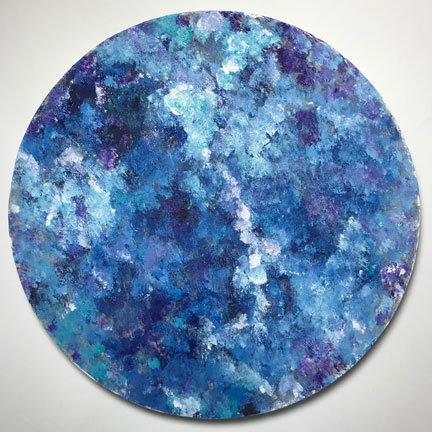
What is your process for choosing which medium to work with on any given project?
When I first start exploring something, I read and watch and take in everything, with minimal editing. I’m interested in how things grab attention, and why they do. I’ll print out journal articles and chase down literature and philosophy.
I want to go places and see things for myself; talk to the people who wrote the articles and books, and music and poetry about them. I take photographs so that I can capture in the moment what caught my eye and provoked even more questions. I’ll print them out, large format if I can: usually 24” x 36” and put them up in my studio. I’ll even print them out on regular printer paper and carry them around, adding notes, tearing or folding them up, taping them into my idea books. They are my aide memoire and more. They are truly my souvenirs in both meanings of that word for me: in English they are my tangible mementos, and in French they represent my memories and remembrances.
You’ve done some interesting sound compositions that use your physical art works. What is the process like to create these pieces and their accompanying scores?
When I paint, it allows me to process, focusing the visual, the theoretical, and the abstract and is often the point at which I really begin to hear the work. I sometimes create studies to play with individual or tangential ideas as I go, pausing work on the central piece. I seem to want to do bigger pieces lately…the one I’ve just started is 5 ft x 10 ft., but the studies can be anything from 4” to 24”. Once the big painting is done, I generally have a sense of what the graphic score could be like. I then start with the outline for the instructions for play.
I fold into the score the elements I want to emphasize from that narrative and begin to play with what that aspect of the score could look like; how could I depict playing the past in the present, for example. With Slippages, I had bespoke paper made with random openings; these openings allowed the past, or what could be seen through the hole from the sheet or sheets below, to be played in the present with all the other elements on the top sheet.
Your work tells stories beyond that of your personal experience. Your “eye”, so to speak, seems directed outward towards the world and your surroundings rather than an internal landscape. Is this a conscious choice on your part? Do you draw from your personal life to interweave into your practice?
Sometimes outward and inward landscapes feel indiscernible.
I think a lot about solastalgia, the philosopher Glenn Albrecht’s idea, that considers the distress that we feel when our environment changes, but we are unable to leave. This distress can arise from something catastrophic, like earthquakes and tornadoes, or from the sound of trees being cut down by chainsaws on a city block. Imagine what it is like for species whose habitats are being irrevocably changed with no means to leave. Or to consider that glaciers indeed have agency but are unable to compete with human’s abilities to contribute to global warming. Although we talk about history repeating itself (and it does certainly seem to – we aren’t the best at learning from experience), the rate and degree of change is alarming.
My personal life interweaves: the Athabasca Glacier I saw when I was 10 is not what I saw when I was 57, and it was disturbing. The bullfrogs at the lake diminished so much in number from when I was 5 to 25 that it went from deafening and constant at dusk to mostly silent and occasional.
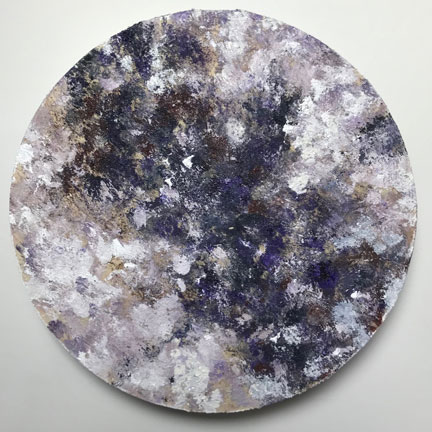
Is there a medium that you feel particularly at home in? What was your first entry point into art?
I’m fickle. Every time I think I have a “one true love” because of how it enabled me to express exactly what I wanted at the time (think paper and acrylic ink with slippages), I inevitably find myself enamoured deeply with another. I think that switching mediums, for me, keeps things fresh and pushes me to experiment.
Mud was probably a first entry point, both sculpturally, and as a medium with which one could paint. I have continued to play with it in some form or other since then.
Marisa Malone grew up in the Sierra foothills of Nevada. She studied writing and literature at The Evergreen State College and currently lives in Brooklyn, NY. Her writing has been published in BlazeVox Journal and Selfish Magazine, along with two self-published poetry chapbooks.
•
The Past Sealed Away by Deborah Carruthers is on view through April 14, 2023 at the Adjacent To Life gallery housed in Ninth Street Espresso (341 E. 10th Street at Ave B, New York City).